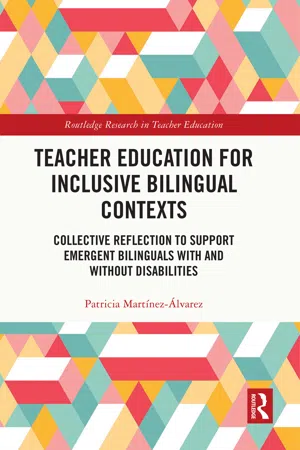
Teacher Education for Inclusive Bilingual Contexts
Collective Reflection to Support Emergent Bilinguals with and without Disabilities
- 252 pages
- English
- ePUB (mobile friendly)
- Available on iOS & Android
Teacher Education for Inclusive Bilingual Contexts
Collective Reflection to Support Emergent Bilinguals with and without Disabilities
About This Book
This text demonstrates how collective reflection can function as a central part of effective teacher preparation for work in inclusive bilingual environments.
Through analysis of rich qualitative data, Teacher Education for Inclusive Bilingual Contexts shows how group reflection supports pre-service educators to recognize the intersectional circumstances faced by students and understand their identities beyond the possible confines of disability. This, in turn, engenders reconceptualization of standardized expectations and implicates the educator in developing student agency through individualized use of routine, language, and materials. The author offers cultural historical activity theory and disability studies in education as a basis for dialectal interactions to unearth contradictions and misunderstandings surrounding language acquisition and the learning of emergent bilinguals and highlight the ways in which educators can disrupt oppressive practices through expansive learning opportunities.
This insightful volume will be of interest to researchers, scholars, and postgraduate students in the fields of inclusive education and disability studies, bilingual and language education, and teacher education.
Frequently asked questions
Information
1 Historical Contradictions in Teacher Education for Inclusive Bilingual Contexts
Introduction
Explaining the Terminology
Historical Contradictions in Teacher Education for Inclusive Bilingual Contexts
Intersectional Deficit Perspectives on Bilingual Children With a Disability
Table of contents
- Cover
- Half Title Page
- Series Page
- Title Page
- Copyright Page
- Dedication
- Contents
- List of Illustrations
- Author
- List of Appendices
- Foreword
- Acknowledgments
- List of Abbreviations
- 1 Historical Contradictions in Teacher Education for Inclusive Bilingual Contexts
- 2 Theorizing Collective Conversations Among Educators for Learning: Defining the Project
- 3 Teacher Education for Inclusive Bilingual Contexts: Theoretical Codes and Collective Reflection
- 4 Attending to All Children: Transforming the Learning Space for Sustained Development
- 5 Rules and the Preparation of Teachers: Structures, Time, and Language Hybridity
- 6 Toward Multidimensional Hybrid Spaces of Learning
- 7 Ableism as a Lens: Interdependence, Flexible Time, and Transformation of Contexts
- 8 Inclusive Bilingual Education: Communities of Educators and Knowledgeable and Resourceful Children
- 9 A Theoretical and Practical Framework for Teacher Education for Inclusive Bilingual Contexts
- Index